Babywearing
Babywearing is the practice of wearing or carrying a baby in a sling or in another form of carrier. Babywearing has been practiced for centuries around the world. In the industrialized world, babywearing has gained popularity in recent decades. Part of the reason for this shift is due to the influence of advocates of attachment parenting. Babywearing is a form of baby transport which can be enjoyed for as long as mutually desired, often until toddlerhood and beyond.[1]
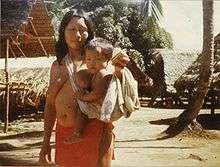
Benefits
Dr. William Sears, a pediatrician, coined the phrase attachment parenting. One of Sears' principles of attachment parenting is babywearing and he attributes many benefits to babywearing and the in-arms style of parenting.
The benefits of babywearing include:
- In the wearing of newborns in particular, the mothers' oxytocin levels are increased through the physical contact with the infant, leading to a more intimate maternal bond, easier breastfeeding and better care, thus lowering the incidence of postpartum depression and psychosomatic illness in the mother;[2] similarly, the father carrying the baby has benefits for the paternal bond.
- Infants who are carried are generally calmer, as more of their primal/survival needs are met. The caregiver can be seen, heard, smelled, touched, tasted, provide feeding and the motion necessary for continuing neural development, gastrointestinal and respiratory health and to establish balance (inner ear development) and muscle tone is constant.[3]
- Parental rhythms (walking, heartbeat, etc.) can have balancing and soothing effects on infants.
- Infants are "humanized" earlier by developing socially. Babies are closer to people and can study facial expressions, learn languages faster and be familiar with body language.[4]
- Independence is established earlier.[3]
- Attachment between child and caregiver is more secure.[5]
- Decreases risk of positional plagiocephaly ("flat head syndrome") caused by extended time spent in a car seat and by sleeping on the back.
Kangaroo care, in which the baby's bare body rests against the parent's bare chest, with or without a baby sling, has shown clear benefits to premature and ill infants.[4]
Studies of parent-child attachment, parental satisfaction and infant crying point to babywearing as a satisfactory arrangement for both parents and baby. Baby carriers and slings help increase the number of hours a day an infant is held, and proponents believe that the more a baby is held, the less the baby cries.[6] However, this experience is not universal; for example, the indigenous Munduruku people of Brazil use baby slings to carry their babies all day. The babies are allowed to nurse freely, and are passed from one woman or girl to another to be carried throughout the day. Yet, the Munduruku babies cry very frequently despite being carried all day.[7][8]
Practicality
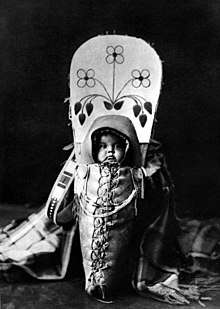
Babywearing allows the wearer to have two free hands to accomplish tasks such as laundry while caring for the baby's need to be held or be breastfed. Babywearing offers a safer alternative to placing a car seat on top of a shopping cart. It also allows children to be involved in social interactions and to see their surroundings as an adult would.[1]
It follows that many sling and soft carrier users have found that carrying their infant is much easier on the back and shoulders than lugging them in a car seat. The weight of the child is spread more evenly across the upper body and they don't have to struggle with a bulky, hard and awkward car seat.[1]
There are many different types of carriers available to purchase or swap, and they can also easily and cheaply be made by the parent or caregiver, also laws in the United States have now limited the legality of manufacturing carriers and slings. Wraps, slings, mei tais, and soft structured carriers with buckles (also referred to as SSCs)make up the vast majority of carriers. In the western world, carriers can also be seen as a fashion statement and be worn as part of an outfit. They come in many different designs and colors and are available in many different types of fabrics from specialist manufacturers, including bamboo, silk, hemp, cotton, wool, fleece, flax/linen and more recently some synthetic blends such as Repreve and Tencel.[1]
Infant feeding and babywearing
Breastfeeding and babywearing often go hand in hand. Many baby slings and other carriers offer mothers privacy and for many mothers, the option of nursing hands-free while tending to other activities or household chores. Not all mothers can nurse hands-free in a baby carrier. Large-breasted mothers and mothers of small or hypotonic infants may need to support the breast or help maintain proper positioning of the baby's head or body. Even so, a properly adjusted baby carrier can help reduce arm strain and allow a mother more freedom of movement while nursing, even if it does not allow her to be completely hands-free.[1]
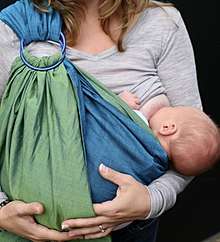
Babywearing can help premature babies and babies who are slow weight gainers to gain weight at a faster rate.[9][10] Since the baby is held up close to the mother, the baby will be able to be nursed more often and often for longer intervals.
Not all parents find breastfeeding in a sling or carrier easy. It is important, before attempting to breastfeed in a carrier, to first master the art of breastfeeding without a carrier. Latch and position are vital, and it is important to establish these first before adding a carrier to the mix. Where breastfeeding difficulties exist, babywearing can simplify the other tasks of parenting by allowing a parent free hands to deal with breastpumps, bottles and other supplementation devices.[11]
Some parents prefer, even with the best carriers, to take time out and sit down to nurse a baby. Some babies may reflexively clamp down when nursing while a parent moves around, so nursing while babywearing is not always entirely comfortable. Individual experience will vary radically not only from parent to parent, but also from baby to baby, even within the same family. Some babies nurse very well in slings and carriers, others do not.
Where breastfeeding is not possible, babywearing can aid attachment by encouraging closeness during bottle feeding. Daycare providers and foster parents often find that babywearing allows them to better meet the needs of multiple children by freeing hands during times when babies need to be held.[1] It is possible to wear two children at once; this is known as tandem babywearing. This can be done with twins or with two children of different ages, for all the reasons of practicality and enjoyment stated above.
Celebrations
Babywearing is celebrated around the world each year during the annual International Babywearing Week. Many countries have formed their own celebrations that run alongside this event such as Australian Babywearing Week. and New Zealand Babywearing Week There are also several babywearing conferences such as WEAR and IBC.
Safety
As with any physical activity, there are certain safety precautions which must be considered in babywearing. Most are common sense, but the guidelines are particularly important to remember when carrying a newborn baby that has limited head control. The acronym TICKS [12] was created to assist with remembering the safety basics of babywearing:
- Tight
- In view
- Close enough to kiss
- Keep chin off the chest
- Supported back
The question has been raised as to whether or not babywearing is safe with respect to falls. In the case of a caregiver accidentally tripping or falling while wearing a baby, the wearer's arms would likely be free to break the fall, while the child remained relatively safe close to the carer's center of gravity. If the child was being carried 'in arms' without a carrier, the likelihood of injury would be much higher due to the impossibility of the carer being able to both hold the child safely and protect themselves from injury.
Exercise with babies in slings and carriers is now a growing way of mothers being able to undertake exercise and movement-based classes with their babies. It has been reported to increase mother-child bonding through physiological and neurological pathways. It is important to find a safe and qualified provider who can ensure the safety of the mother and the baby in the particular exercise class. Babywearing yoga is particularly popular as it does not involve bouncing and moving fast whilst carrying baby in slings.
Further reading on the subject of babywearing safety can be widely found.[13][14]
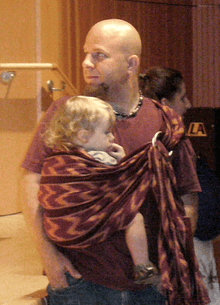
Popular Carrier Types
The popularity of baby wearing has brought with it an explosion of types and brands of baby carriers, such as the woven wrap, stretchy wrap, ring sling, mei tai, pouch carrier, soft structured carrier, and backpack baby carrier.[15] and in the past years also breezy carriers made of dri fit fabrics to be used in hot weathers and in water activities
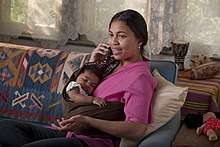
See also
References
- Blois, M, MD. (2005). Babywearing: The Benefits and Beauty of This Ancient Tradition. Pharmasoft Publishing.
- ""Regulation of anxiety during the postpartum period"", Lonstein, Joseph S., Frontiers in Neuroendocrinology, Volume 28, Issues 2-3, August–September 2007, Accessed 2009-05-09
- Morris, D. (1992). What Comforts a Baby? In Babywatching (pp 80-82). New York: Crown Publishers Inc.
- Kitzinger, Sheila. (1989). The Crying Baby. Penguin Books.
- Anisfeld, E., Casper, V., Nozyce, M., & Cunningham, N. (Oct., 1990). Does Infant Carrying Promote Attachment? An Experimental Study of the Effects of Increased Physical Contact on the Development of Attachment. Child Development, Vol. 61, No. 5, 1617-1627.
- Klaus, M., Kennell, J., Klause, P: Bonding, pp 126,204-5. Addison Wesley Publishing Company, 1995.
- Burkeman, Oliver (2018-01-16). "The diabolical genius of the baby advice industry". The Guardian. ISSN 0261-3077. Retrieved 2018-03-06.
- Murphy, Yolanda; Murphy, Robert Francis (2004). Women of the Forest. Columbia University Press. p. 196. ISBN 9780231132329.
- Hasselmeyer, E. G. (1964). The premature neonate's response to handling. Journal of the American Nursing Association, I. 15-24.
- Solkoff, N, et al. (1969). Effects of handling on the subsequent development of premature infants. Developmental Psychology, 1(6). 765-768.
- "Breastfeeding in a Carrier" Archived 2016-10-23 at the Wayback Machine, TheBabywearer.com Wiki.
- http://www.schoolofbabywearing.com/Images/TICKS.pdf
- "Archived copy". Archived from the original on 2014-07-15. Retrieved 2014-07-17.CS1 maint: archived copy as title (link)
- "Archived copy". Archived from the original on 2014-06-30. Retrieved 2014-07-17.CS1 maint: archived copy as title (link)
- "Babywearing: Types of Slings and Carriers". Baby Centre. September 2016.
| Wikimedia Commons has media related to Baby slings. |